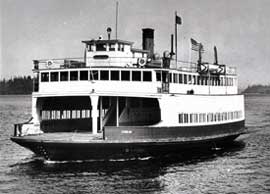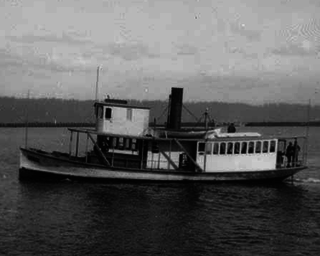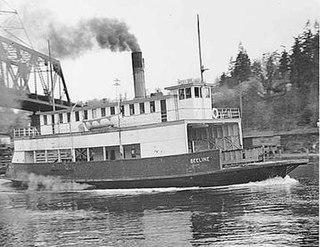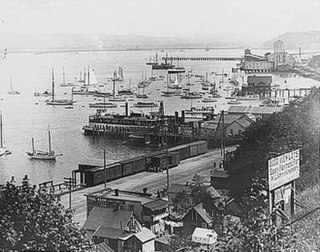Course of business
In 1882, Emmett E. built a little steamboat, Baby Mine, just 26' long, and his brother Arthur.M. came on board as the engineer. They built or operated for others additional boats including Gypsy Queen, Susie and Victor. [1]
In 1898, the Hunt Brothers had Sentinel built at the Crawford and Reid shipyard in Tacoma, and placed her on the East Pass Route between Tacoma and Seattle. In 1899, they had Crest built at Tacoma for service on the Tacoma-Gig Harbor route [2]
In 1902, the partnership ended, and Emmett Hunt took over the Crest on the Gig Harbor route. and appears to have continued in business until at least 1907 as the Hunt Steamboat Company. Arthur M. Hunt kept Sentinel and the sternwheeler Clara Brown.
In 1905, Arthur M. Hunt and Frank Bibbins formed the Tacoma and Burton Navigation Company. Arthur M. Hunt designed Burton, launched 1905, and Magnolia launched 1908. One authority states that about three years later, Arthur M. Hunt sold both boats (Sentinel going to the newly formed Merchants Transportation Company) and quit the steamboat business. [3] Another authority indicates that Arthur M. Hunt bought out Bibbins' interest in a shipyard on the Puyallup river, where he superintended the construction of boats such as Ariel (1912). [4]
In May 1913, the Hunt Brothers, consisting of Arda R., Arthur M., and Lloyd) launched Atalanta, built at the Marine Supply Company in Tacoma, as a replacement for Crest on the Gig Harbor route. Atalanta was a 147-ton steamer, measuring 111.7' long, 23' on the beam, and 6.7 depth of hold. Captain A.R. Hunt, who had been in command of Ariel'' on the same route, took over as her skipper. Captain Hunt's son, Reed Hunt, who later became chairman of the board of the Crown Zellerbach corporation, recalled the launching of Atalanta:
Three little boys stood at the bow and sang out in unison, 'I christen thee Atalanta! ... my two cousins and I. In June 1917, I went aboard as a deckhand and spittoon cleaner to help out during the wartime labor shortage. That five-cylinder engine was something. It came from a twin-screw yacht in New York and I can still hear my dad arguing with his brother Arthur that they should have bought both engines -- one for a spare. She cruised rather easily at 18 miles per hour and when we closed off the first cylinder and bypassed live steam to the second etc. she'd hold 22 until the steam ran out. [5]
In 1914, the Hunt Brothers sold Ariel to Henry and Marcus Johnson, who brought her up to Lake Washington to run in the suburban passenger business. [6]
In 1924, Pierce County decided to go into the automobile ferry business and built the 124' City of Tacoma to run between Tacoma and Gig Harbor. Arthur M. Hunt designed the ferry and the Hunt Brothers operated it for the county until 1927, when a new ferry, the Defiance was built at Gig Harbor for the Skansie Brothers and their Washington Navigation Company, who took over operation of ferries for Pierce County on the Tacoma, Gig Harbor and Vashon Island runs. [7]

The MV Crosline was a wooden, diesel ship launched in Seattle on June 22, 1925 for the Crosby Direct Line Ferry Company. It could carry 300 passengers and 65 cars.

Lake Washington steamboats and ferries operated from about 1875 to 1951, transporting passengers, vehicles and freight across Lake Washington, a large lake to the east of Seattle, Washington. Before modern highways and bridges were built, the only means of crossing the lake, other than the traditional canoe or rowboat, was by steamboat, and, later, by ferry. While there was no easily navigable connection to Puget Sound, the Lake Washington Ship Canal now connects Lake Washington to Lake Union, and from there Puget Sound is reached by way of the Hiram M. Chittenden Locks.

The King and Winge Shipbuilding Company was an important maritime concern in the early 1900s on Puget Sound. The shipyard was located at West Seattle. The owners were Thomas J. King (1843–1925) and Albert M Winge. King was born in Boston and learned to build ships under the famous Donald McKay. He came to Puget Sound in about 1880, and worked in the shipyards of Hall Bros. and T.W. Lake before starting his own shipyard with Winge. King’s partner, Albert L. Winge was a native of Norway.

The steamboat Defiance operated in the early 1900s as part of the Puget Sound Mosquito Fleet. In later years this vessel was called Kingston.

The steamboat Monticello (2) operated in the early 1900s as part of the Puget Sound Mosquito Fleet. The vessel went through several reconstructions and remained in service until 1962, when she was lost in Alaska waters. Her later names were Penaco and Sea Venture. (This Puget Sound steamer should not be confused with the smaller Monticello, which also ran on Puget Sound, but was built in 1895 for Captain Z.J. Hatch of the Monticello Steamship Company.

The steamboat Rosalie operated from 1893 to 1918 as part of the Puget Sound Mosquito Fleet, also operating out of Victoria, B.C. In 1898, Rosalie went north with many other Puget Sound steamboats to join the Klondike Gold Rush.

The Greyhound was an express passenger steamer that operated from the 1890s to about 1915 on Puget Sound in Washington, United States. This vessel, commonly known as the Hound, the Pup, or the Dog, was of unusual design, having small upper works, but an enormous sternwheel. Unlike many sternwheelers, she was not intended for a dual role as passenger and freighter, but was purpose-built to carry mostly passengers on express runs.

Tacoma was a steamship that served from 1913 to 1938 on Puget Sound. Built of steel, Tacoma was known for being one of the fastest and best-designed vessels to operate on Puget Sound. Tacoma was particularly noted for high-speed service from 1913 to 1930 on the route between Tacoma and Seattle.

Victor was a steam-powered tugboat built in 1893 in Tacoma, Washington. This vessel should not be confused with the similarly named Victor II, also active in Puget Sound.

Burton was a steamboat built in 1905 in Tacoma, Washington and which was in service on Puget Sound until 1924.
The Kitsap County Transportation Company was an important steamboat and ferry company that operated on Puget Sound. The company was founded in 1898 as the Hansen Transportation Company.

Crest was a wooden steamboat that operated on Puget Sound in the early 1900s. Following a sale of the vessel in May, 1912, this boat was known as Bay Island.

Florence K was a steamboat that was operated on Puget Sound from 1903. This vessel was later renamed Gloria and was rebuilt as a steam ferry and renamed Beeline.

West Seattle was a side-wheel driven steam-powered ferry built in 1907.

The West Seattle Land and Improvement Company was a real estate development concern that conducted business in West Seattle starting in 1888. Through a subsidiary, the Oregon and Washington Ferry and Navigation Company, the company also owned and operated two ferries that operated between the company's developments in West Seattle and Seattle itself, which was then a separate city which was difficult to reach over land routes of the time.

King County was a steam ferry built in 1900 which served on Lake Washington until 1908.

The Seattle–Bainbridge ferry is a ferry route across Puget Sound between Seattle and Bainbridge Island, Washington. The route was called the Seattle–Winslow ferry before the city of Winslow annexed the rest of the island and changed its name. Since 1951 the only ferries employed on the route have belonged to the Washington state ferry system, currently the largest ferry system in the United States.

Concordia was a steamboat that ran on Puget Sound from 1930 to 1976. Although later converted to diesel power, Concordia was the last inland commercial steamboat ever built on either Puget Sound or the Columbia river.

Atlanta was a steamboat built in 1908 at Houghton, Washington which served on Lake Washington and Puget Sound until 1938, when it was converted into a diesel-powered houseboat.

Speeder was a motor launch built in 1908 which served on Puget Sound and in the San Juan Islands. From 1908 to 1922 this vessel was named Bainbridge.



















